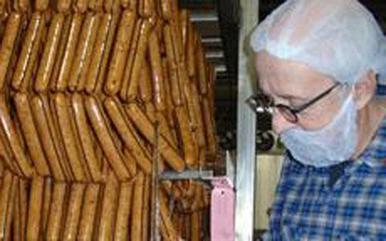
This is the VOA Special English Agriculture Report.
Some people in the Netherlands are spending 330,000 dollars on a hamburger. The people are scientists at the University of Maastricht. They want to prove that they can make a hamburger that tastes good and does not require an animal to be killed.
Researcher Mark Post and his team have been growing muscle-tissue cells in a laboratory with muscle taken from a cow.
MARK POST: "We have committed ourselves to make a couple of thousand of these small tissues and then assemble them into a hamburger."
Several teams around the world are trying to produce meat without killing animals. So far the Dutch team appears to have made the most progress.
Mr Post says he wants to show that the world's growing demand for meat could be satisfied more efficiently and with less harm to the environment.
MARK POST: "It's a combination of the two things, care for environment and food production for the world. And second is just a generic interest in life-transforming technologies."
Seth Tibbott is the founder of Turtle Island Foods in Hood River, Oregon.
SETH TIBBOTT: "This is some of our flagship product, the Tofurky roast, being made, where the stuffing is inside... "
His company makes a vegetarian turkey substitute called Tofurky. Tofurky is made from tofu. Tofu is made with soybeans. So what does Mr Tibbott think of the idea of a hamburger made in a lab?
SETH TIBBOTT: "I think it sounds still pretty disgusting."
His company estimates that about three percent of Americans are vegetarian. Vegetarians do not necessarily want food that tastes like meat. But Seth Tibbott says a lot of other people might try meatless alternatives if those products did look and taste more like real meat.
SETH TIBBOTT: "In the industry, they're called flexi-tarians or they're called 'sometimes vegetarians.' And, depending on what study you look at, they're 30 to 40 percent of America."
Turtle Island Foods is building a new Tofurky factory. It will let the company make three times as much Tofurky starting next year.
Biochemistry professor Patrick Brown at Stanford University in California has started his own company developing a meat substitute. His food scientists are working with plant proteins and oils to try to reproduce the look and taste of the real thing. But he says whatever they produce will also need a price that appeals to meat lovers.
PATRICK BROWN: "What we're intending to do is basically produce stuff that will compete by being substantially cheaper and every bit as good and essentially indistinguishable to a consumer who loves meat or dairy. That's the only way I think you're really going to win in the market."
The American beef industry uses the marketing slogan: "Beef, it's what's for dinner." Jack Field is the director of the Washington Cattlemen's Association, in Washington state. He says he is not too worried about competition from fake meat. In his words, "Real beef will be what's for dinner, now and into the future."
And that's the VOA Special English Agriculture Report. You can find captioned videos of our programs at the VOA Learning English channel on YouTube. I'm Jim Tedder.
Tofurky: 素火鸡
flexi-tarians: [flexi(ble) + (vege)tarian.]灵活的素食者
(来源:VOA 编辑:Rosy)
